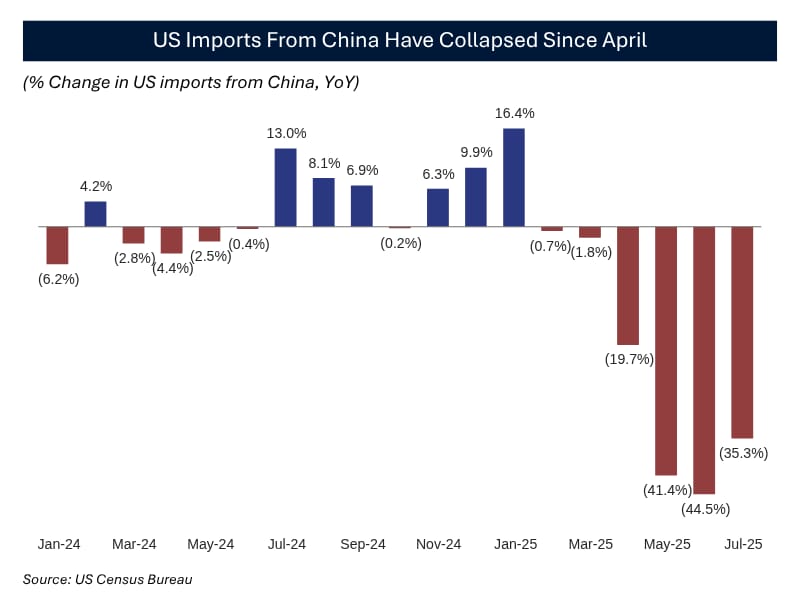|
China’s rise has fractured the global trading system.
Two weeks ago, Beijing announced new export restrictions on several rare earth metals, critical inputs for everything from consumer goods like smartphones to strategically critical technology like fighter jets and AI compute.
The US responded in kind, with President Trump enacting 100% tariffs on Chinese goods set to take effect on November 1st.
The most likely outcome from this trade spat is another temporary truce.
But the flare-up reflects a clear geopolitical shift: the world’s two primary economic and military powers have moved into direct conflict.
US-China Trade Has Plummeted

The US is now taking aim at China’s dominance in global trade.
The pushback follows decades of heavy outsourcing to China after the country’s admission to the World Trade Organization in 2001.
Powered by a massive low-wage labor force and strong government support, China quickly became the default manufacturing hub for US and international corporations.
This wave of industrialization fueled China’s rise to the world’s second largest economy and leading manufacturer. Today, China produces nearly a third of global output, dwarfing its competitors.

And this scale has become a vulnerability for the West. As China has risen on the global stage, the US and allies have become increasingly concerned about economic dependence on their geopolitical rival:
Fragile global supply chains, which face massive disruption during crises or conflict
The hollowing out of domestic industries
China’s ability to weaponize trade
In response, the US and Western countries have turned to protectionism.
President Trump has used tariffs to sharply cut Chinese imports since the Liberation Day announcement in April. Even after partial rollbacks of initial tariff rates, China faces a 58% effective tariff rate today.1
Similarly, the EU is currently assessing tariffs of 25%-50% on Chinese steel.2
China Controls the Chokepoints

As trade tensions escalate, the US and other countries are scrambling to confront Beijing’s most potent leverage: its central position in the global supply chain.
Rare earths are just the tip of the iceberg.
China manufactures nearly double the output of the next largest country, the United States, and controls chokepoints across a range of strategically critical products and resources:
90% of rare earths refining
85% of battery cell production capacity
80% of solar panel manufacturing capacity
63% of antibiotic API production
54% of global steel production
The rare earth export controls announced in October demonstrate that China is increasingly willing to weaponize its trade dominance against rivals.
Economic Security is National Security
The logic of globalization has flipped.
For decades, economic integration with China was seen as a driver of efficiency and growth.
Today, economic dependence is a national security risk.
US policy has shifted accordingly. The government has turned interventionist in the name of economic and national security.
The Biden administration's CHIPS Act subsidized domestic semiconductor production. The Trump administration has pushed further, promoting reshoring and even taking equity stakes in US companies.
Recent US economic policy looks closer to Chinese economic policy than traditional US capitalism.

But as US-China rivalry intensifies, this forced decoupling is inevitable. It is untenable to have economic dependence on your primary geopolitical rival.
Economic interventionism and protectionism are the new normal.
The information contained herein should not be construed as legal, investment, accounting or other professional services advice on any subject. ILLIQUID INSIGHTS LLC, its affiliates, officers, directors, partners and employees expressly disclaim all liability in respect to actions taken or not taken based on any or all the contents of this publication. Furthermore, opinions expressed by participants herein are not the opinions of ILLIQUID INSIGHTS LLC. Copyright © 2025 ILLIQUID INSIGHTS LLC. All rights reserved.
